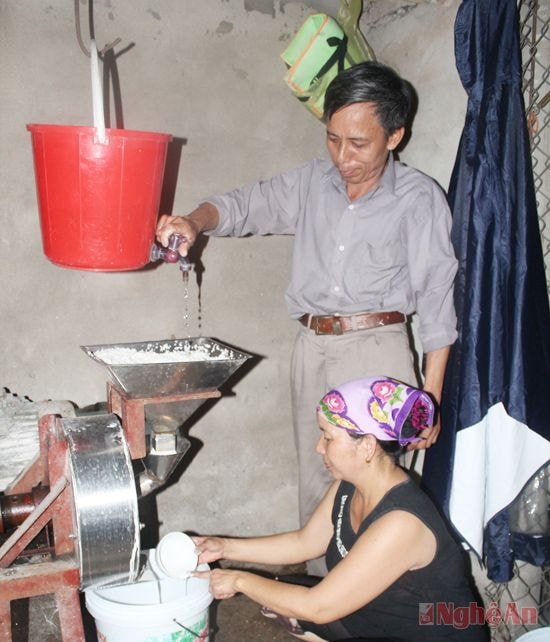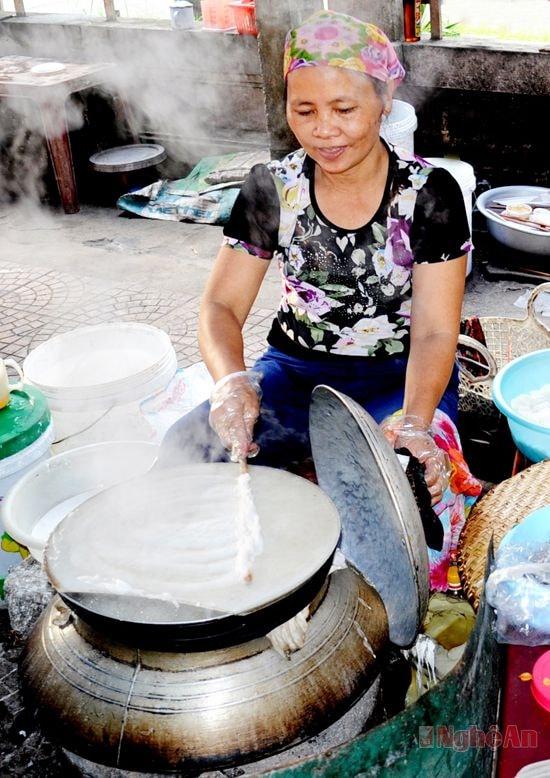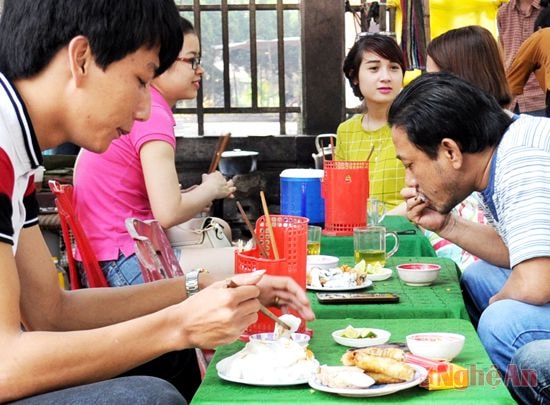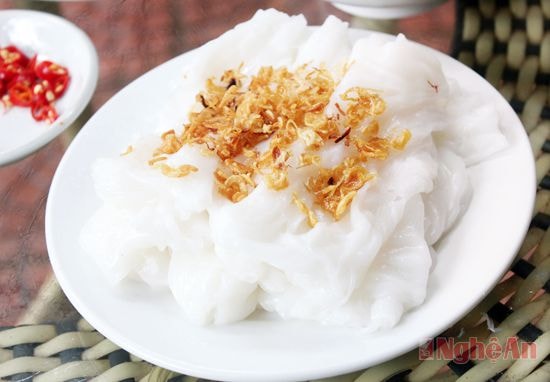Dong Khanh rice rolls - delicious coastal dish...
(Baonghean) - "When asked what the original name of the old village of Dong Khanh block was, Mr. Nguyen Sy Quang no longer knew. He only remembered that the first person to make banh muot (rolls) in this area was Mrs. Duong in Tay Khanh block now, and the day his mother gave him a full bowl of banh muot was 56 years ago. That means in 1964? Mr. Quang nodded his silver-colored head, then said: Mrs. Duong's banh muot with stinking shrimp paste was so delicious it was almost deathly delicious!"...
Who hasn't suddenly wanted to satisfy their desire to go to the sea at some point in the beginning of the "Central sunshine" in late April? In Hanoi or in Vientiane, Laos, dreaming about the gentle, caressing waves of Cua Lo is crazy; so coming to Cua Lo when the tail of the Lao wind starts to tease and bring the "special" heat, the pleasure of diving under the waves here can only be described as melting! But then we were both melted and "wanted to die" when we picked up a thinly spread rice paper and slid it into the "sound-like" dipping sauce, mixed with golden, crispy fried onion flakes... and just like that, let our eyes, nose, and mouth do the work that is both instinctive and exploratory, explaining a delicious dish that can easily be included in the culinary guide of Cua Lo tourism.
 |
| Flour milling stage |
The tarps and umbrellas of the breakfast banh muot stalls with the sign "banh cuon" on Sao Nam Street in Cua Lo now belong to Dong Khanh noodle village. Cua Lo has several famous seafood processing villages with shrimp, grilled mackerel, fish sauce, shrimp paste... which are familiar to many tourists, but Dong Khanh noodle village is not known by many people even though it was awarded a certificate of recognition as a village in 2009. And this is the only agricultural processing village in the coastal town. That means customers who eat banh muot in the center of Cua Lo beach, all the cakes are from Dong Khanh village! The owner of the banh muot stall, Tran Thanh Van, smiles and shows that he is the only person in the village who supplies hot banh muot to restaurants and hotels when they need it.
Why is he the only one? For two reasons: first, he "bears" the red invoice tax registration fee, second, each family in the village does business in their own way, without competing with each other. Normally, his family can take care of the breakfast needs of hotel guests, but during peak times, other families just "entrust" it to him. His daughter also follows the profession, considered a family business, but when registering a business location, it is also a "brand" with the name of the couple, with the sign "Luong - Van Hot Rice Rolls". He "leaves" the processing and making of ham to his son-in-law. It is a joint venture based on absolute trust!
Dong Khanh wet rice cake has its own uniqueness because the village only makes wet rice cake, not vermicelli like other wet rice noodle villages. So this is probably the only wet rice cake village in Nghe An. Making only one dish like that requires a refined craft; surely because of the demands of the culinary market, and this is the culinary market of a coastal tourist city that welcomes over a million visitors each season, which is no joke! But the origin of the craft also partly determines...
 |
| Cake coating. |
Mr. Nguyen Sy Quang claims to be a descendant of many generations rooted in Cua Lo. The time he “wanted to die” more than half a century ago when eating Mrs. Duong’s banh muot, Cua Lo was just a small town, with casuarinas and bamboo “eating” the entire village landscape. Banh muot trang sold at Mrs. Duong’s house was considered the only street food in the whole village and naturally it was something that children were not always generously given money by adults to eat. The banh muot stall, surrounded by bamboo fences and dense bamboo arches, was not only a place to attract the cravings of gluttonous children during times of poverty, but also a joy for the elderly villagers, taking the bustle of firewood and flickering oil lamps at Mrs. Duong’s banh muot stall to relieve the difficulty of waking up early...
Then the US bombed the North, causing chaos in the village. Mr. Quang no longer had the chance to "want to die" again at Mrs. Duong's wet rice cake shop. War, hunger, and lack of clothing were daily torments, but people's minds were overwhelmed by bombs, death, and even hatred; suddenly growing up, suddenly joining the army, suddenly returning home, after decades as a village chief and party cell secretary, Mr. Quang officially retired from "carrying the prison and" the Dong Khanh block of Thu Thuy ward a few months ago. And about the Dong Khanh rice cake village, he was the most "overseeing" person...
“After that, it seems that Mrs. Duong taught the craft to a few households. Then, in 1994, when Cua Lo became a town, several households in Dong Khanh got together to make banh muot, selling at home, selling at the market, and gradually there were associations and boats, up to a few dozen households doing it together. When the craft village was recognized, the town drew lots for business locations, and only 15 households won. Now there are only 12 households doing it, but it is a sustainable direction and will develop well in the future if the brand is built,” said Mr. Quang.
Talking about building a brand for banh muot is a serious matter. In Hanoi and Saigon, there are banh cuon (muot) brands that have created a chain of breakfast restaurants with revenue of billions of dong per month. And in general, an important factor in building a brand for banh muot is the dipping sauce. Mr. Quang excitedly said: “I once told people that for the craft village to survive, of course, the first thing is to sell well, so it is a matter of pleasing regular customers all year round; but during the tourist season, you have to learn skills such as listening to the accent to recognize customers from which region to choose, and adjusting the dipping sauce, focusing on using Nghi Thuy and Cua Hoi fish sauce, finding a way to eat it with Nghe An shrimp paste, for example...”.
Ask Mr. Tran Thanh Van, he said of course it is like that, regular customers from Nghe An always prefer Chinsu, Nam Ngu everywhere... And tourists from other provinces coming to Cua Lo, always ask for the local fish sauce, after eating they still ask for directions to the craft village to buy as gifts. Well, selling banh muot is also very exciting, so his breakfast stall is only 24 square meters according to the town's regulations, the canvas must also be welded and roofed according to standards, cannot expand but still have to hire 3-4 young men to serve tables, work less than 1 session a day but still pay 70,000 to 100,000 each. Mr. Van mumbled and said: Calculating, after expenses, my wife and I only make a profit of about 70 million VND/year. But the job is sustainable. Moreover, doing the job does not waste anything, rice water, flour milling, waste from customers, some farmers order a few million VND/month in advance, they come to collect everything every day...".
 |
| Breakfast with a plate of wet pancakes |
Making hot rice rolls only sells breakfast, but the whole day is not idle. Dong Khanh has grown in size but still retains its village character. Entering the house of Ms. Vuong Thi Mao, who has been doing the job for 15 years. She said that her family is one of the first 4 households in the craft village to invest over 15 million VND to buy an electric flour mill, in addition to grinding for her family, they also grind for other households in the craft village, only taking the electricity fee, helping each other is the main thing! The "Tinh Mao hot rice rolls" shop is familiar to many tourists coming to Cua Lo. This afternoon, like many other households, first she goes to the market, buys the necessary ingredients, then grinds the flour, roasts onions, orders the ham and rolls the spring rolls... ready for tomorrow. That is a leisurely day, but during the tourist season, they work hard to prepare until nine or ten o'clock at night...
Dong Khanh Banh Muot has 2 types: "vegetarian" Banh Muot eaten with ham and Banh Cuon with meat and wood ear eaten with nem. The secret is to make the cakes always white and smooth; "vegetarian" Banh Cuon looks like silk, Banh Cuon with meat and wood ear eats as if there is no greasy meat filling, the bite when lifted to the mouth seems elegant, but once eaten, the plate is clean, the rest is gone before you know it... And of course, it must be eaten hot. The vendor is generous and says "yes" sweetly like sugar cane, her hands with spoon and chopsticks are as agile as dancing, in a flash she has "brought out" a plate of ten Banh Muot like one and immediately the waiters quickly bring ham and nem according to the customers' requests, and a bowl of dipping sauce to their taste is right in front of them so that the customers can eat it hot right away...
 |
| Dong Khanh wet rice cake. |
No one can bring the sea to the forest to open a beach bathing service there. So the millions of tourists coming to Cua Lo every year, just needing one-tenth of the hot banh muot for breakfast is a lot of work for the people of Dong Khanh craft village, because no one can keep the banh muot warm from Vinh or Nghi Loc!... Mr. Duc - the new Party Secretary of Dong Khanh bloc said this calmly and said: "In Dong Khanh banh muot craft village, besides 8 households registering business locations on the main streets, there are 4 households selling in the markets. Now, if anyone outside the craft village wants to open a banh muot business, there is no place to do business. Therefore, the people of the craft village do not have to worry about competition, so they have to hone their craft even more. The most important issue now is to receive support from the superiors in training on business skills to serve tourism"... Mr. Quang added: "Dong Khanh village's banh muot is delicious and of good quality, but it is equally important to ensure that customers feel clean and comfortable... That is the culture of tourism".
We had that feeling when sitting on the sidewalk of Sao Nam street, welcoming the cool sea breeze and the morning sun, enjoying hot Dong Khanh - Cua Lo rice cakes amidst the bustling voices of tourists coming to the coastal town on the weekend, enjoying many seafood specialties, but still not forgetting to add to our culinary guide a rustic dish that has enriched the interesting and charming features of this top coastal tourist city in the North!
Mr. Vu






